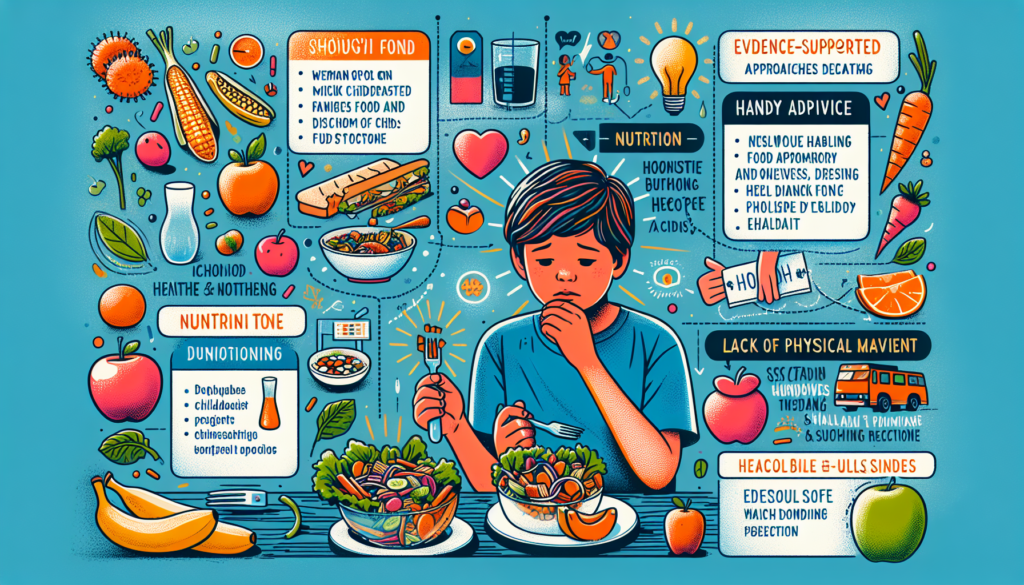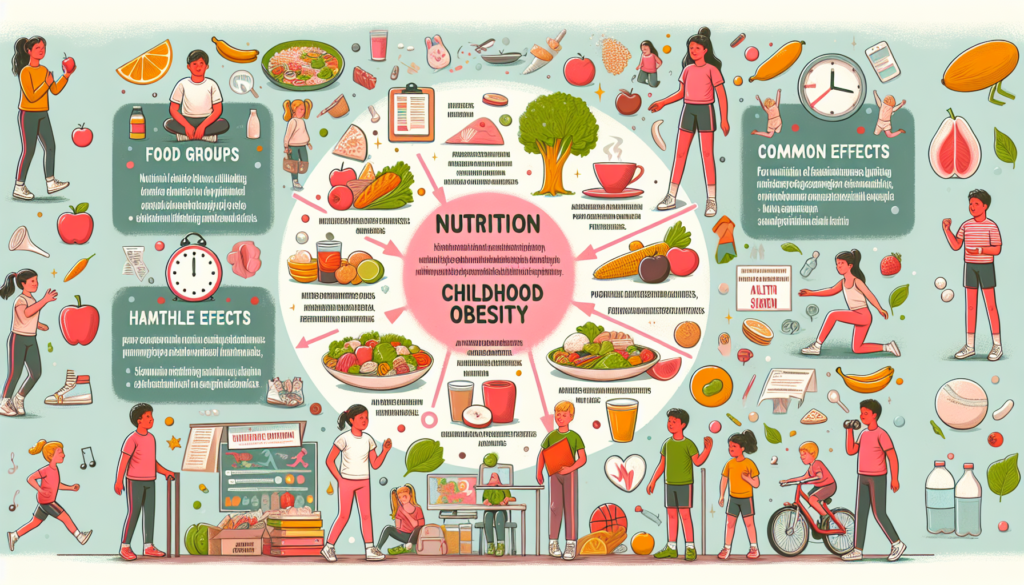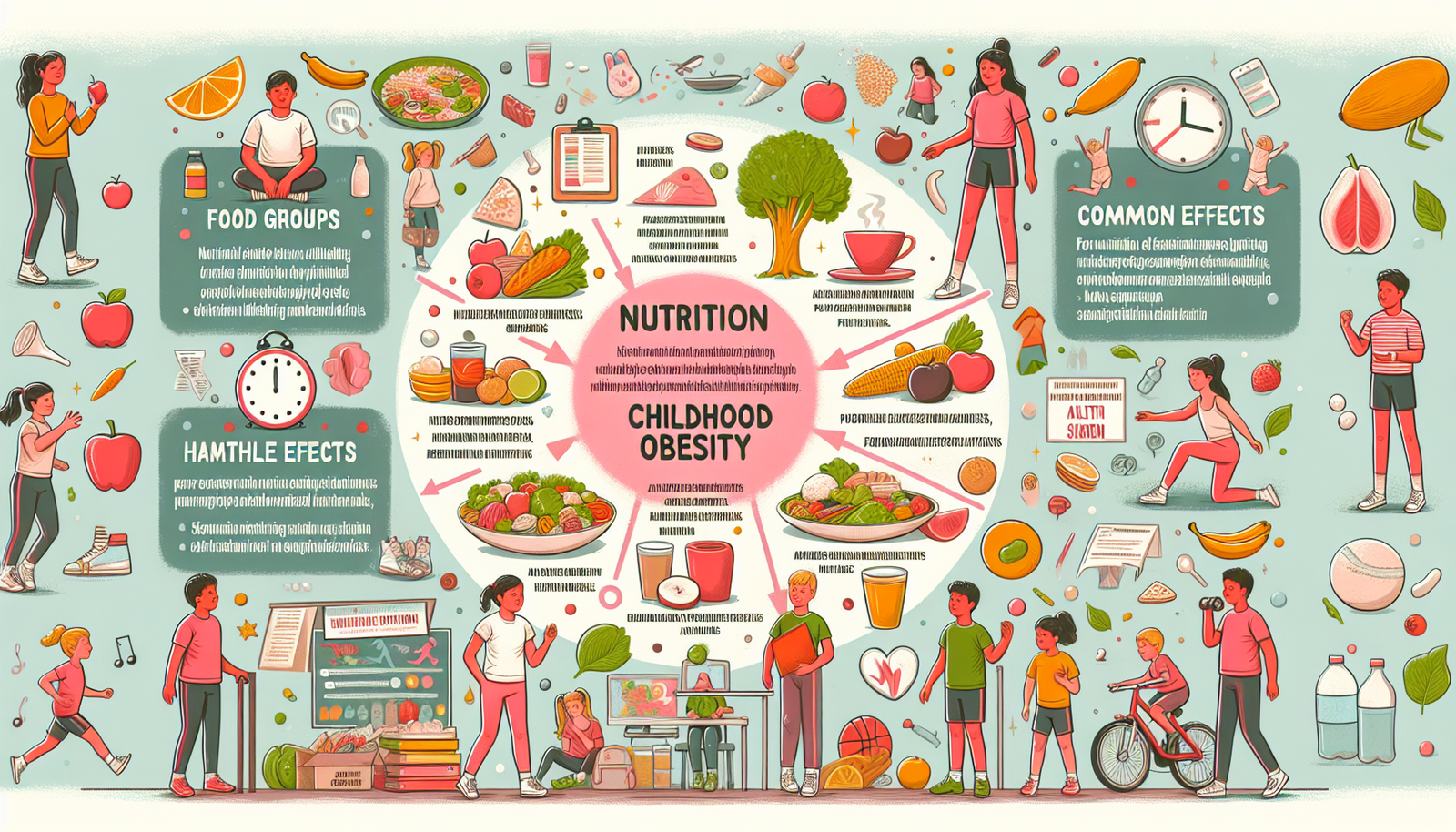Hey there! Are you looking for some practical tips on how to tackle childhood obesity? Well, look no further! In this article, we’ll explore the power of nutrition in conquering childhood obesity. We’ll delve into the importance of a balanced diet and how small changes in food choices can make a big difference. So grab a cup of tea, sit back, and get ready to learn about the incredible impact that nourishing our bodies can have on our children’s health and well-being.
Understanding Childhood Obesity
Childhood obesity is a serious health issue that occurs when a child is significantly overweight or has excess body fat. It is a condition that can have long-term impacts on a child’s physical and mental well-being. The causes of childhood obesity are multi-faceted and can vary from genetic factors to environmental influences.
One of the primary causes of childhood obesity is an imbalance between energy intake and expenditure. This means that children are consuming more calories through their diet than they are burning through physical activity. Sedentary behaviors, such as excessive screen time and lack of exercise, contribute to this energy imbalance. Additionally, genetic factors, family history, and socio-economic conditions can also play a role in the development of childhood obesity.
Prevalence of Childhood Obesity
Childhood obesity has reached epidemic proportions around the world. According to the World Health Organization (WHO), the global prevalence of obesity in children and adolescents has increased dramatically in the past few decades. In many countries, the number of overweight or obese children has tripled or even quadrupled.
In the United States, for example, recent data from the Centers for Disease Control and Prevention (CDC) show that approximately 19% of children and adolescents aged 2-19 years are obese. This equates to around 14.4 million children who are at an increased risk of developing chronic health conditions, such as diabetes, heart disease, and certain types of cancer.

Health Risks Associated with Childhood Obesity
Childhood obesity is not just a cosmetic issue, but a serious health concern. It can have both immediate and long-term health consequences for children. Obese children are more likely to develop cardiovascular disease, high blood pressure, type 2 diabetes, and respiratory problems. They are also at a higher risk of developing psychological and social issues, including low self-esteem and depression.
Furthermore, childhood obesity tends to track into adulthood. Obese children are more likely to become obese adults, increasing their risk of developing chronic diseases later in life. Therefore, addressing childhood obesity is crucial for preventing future health problems and improving the overall well-being of individuals.
The Role of Nutrition in Conquering Childhood Obesity
Nutrition plays a fundamental role in conquering childhood obesity. Providing children with a balanced and nutrient-rich diet is essential for their growth and development, as well as for maintaining a healthy weight. Here are some key aspects of nutrition that can help in the fight against childhood obesity.
Balanced and Nutrient-Rich Diet
A balanced diet is essential for children’s overall health. It should include a variety of foods from different food groups, providing essential nutrients such as vitamins, minerals, protein, carbohydrates, and healthy fats. Encouraging children to consume a wide range of fruits, vegetables, whole grains, lean proteins, and low-fat dairy products can help optimize their nutrition intake.
Importance of Portion Control
In addition to the types of foods consumed, portion control is crucial in managing childhood obesity. Teaching children about appropriate portion sizes and encouraging them to listen to their body’s hunger and fullness cues can help prevent excessive calorie intake. It is also important for parents and caregivers to model healthy portion sizes during mealtime.
Limiting Sugar and Processed Foods
Sugar-sweetened beverages, high-calorie snacks, and processed foods contribute significantly to childhood obesity. These foods are often high in added sugars, unhealthy fats, and empty calories. Limiting the consumption of sugary drinks and snacks, and instead promoting healthier alternatives, such as water, fruits, and homemade snacks, can make a significant impact in managing and preventing childhood obesity.

Encouraging Healthy Eating Habits
Promoting healthy eating habits is crucial in conquering childhood obesity. Parents, caregivers, and educators play a pivotal role in shaping children’s attitudes towards food and establishing positive eating behaviors. Here are some strategies to encourage healthy eating habits in children.
The Role of Parents and Caregivers
Parents and caregivers are the primary influencers of a child’s eating habits. By modeling healthy eating behaviors, providing nutritious meals and snacks, and involving children in meal planning and preparation, parents can create a positive food environment that supports healthy choices. It is important to offer a variety of healthy options and avoid using food as a reward or punishment.
Creating a Positive Food Environment
Creating a positive food environment at home and in schools can have a significant impact on children’s eating habits. This includes providing access to nutritious foods, such as fruits and vegetables, whole grains, and lean proteins, while limiting the availability of unhealthy snacks and sugary beverages. It is also important to cultivate a positive and non-judgmental atmosphere around food and eating.
Meal Planning and Preparation
Meal planning and preparation can help ensure that children have access to healthy and balanced meals throughout the week. Involving children in the planning and preparation process can make mealtime more enjoyable and encourage them to try new foods. Parents can also use this opportunity to teach children about nutrition and the importance of making healthy choices.
Promoting Physical Activity
In addition to a healthy diet, regular physical activity is essential for managing and preventing childhood obesity. Engaging in physical activities not only helps children maintain a healthy weight but also promotes overall physical and mental well-being. Here are some ways to promote physical activity in children.
Benefits of Regular Exercise
Regular exercise offers numerous health benefits for children, including improved cardiovascular health, increased strength and flexibility, better mood, and enhanced cognitive function. It can also help children maintain a healthy weight and reduce the risk of developing chronic diseases later in life. Encouraging children to engage in at least 60 minutes of moderate to vigorous physical activity every day is recommended.
Types of Physical Activities for Children
There are many types of physical activities that children can participate in to stay active and healthy. These include aerobic exercises, such as running, biking, swimming, and dancing, as well as strength-building activities, like push-ups, sit-ups, and climbing. It is important to choose activities that are age-appropriate and enjoyable for children, as this will increase their motivation to participate regularly.
Making Physical Activity Fun and Engaging
To ensure that children maintain an active lifestyle, it is crucial to make physical activity fun and engaging. Parents and caregivers can organize family outings that involve physical activities, such as hiking, biking, or playing outdoor games. Joining sports teams or community recreation programs can also provide opportunities for children to be physically active while socializing with peers. Incorporating technology, such as fitness apps or video games that promote physical movement, can also make exercising more enjoyable for children.
Addressing Emotional Eating and Food Addiction
Emotional eating and food addiction are significant factors that contribute to childhood obesity. It is important to recognize and address these issues to promote healthier eating habits and overall well-being in children. Here are some strategies to address emotional eating and food addiction.
Recognizing and Managing Emotional Eating
Emotional eating is the tendency to consume food as a response to emotions, rather than true hunger. Helping children recognize their emotions and understand the difference between emotional hunger and physical hunger is crucial. Encouraging the use of alternative coping mechanisms for emotions, such as talking, journaling, or engaging in activities they enjoy, can help prevent emotional eating episodes.
Understanding Food Addiction in Children
Food addiction is a complex issue that can contribute to overeating and weight gain in children. Understanding the signs and symptoms of food addiction, such as cravings, loss of control, and withdrawal symptoms, is important for parents and caregivers. If a child is suspected to have a food addiction, seeking professional help, such as therapy or counseling, can provide the necessary support and intervention.
Seeking Professional Help
In cases where emotional eating or food addiction is affecting a child’s physical and mental well-being, seeking professional help is crucial. Healthcare professionals, such as pediatricians, dietitians, or psychologists, can provide guidance, counseling, and intervention strategies to address these issues. They can also work collaboratively with parents, caregivers, and educators to develop personalized plans to overcome emotional eating and food addiction.
Teaching Nutritional Education
Teaching nutritional education in schools is a powerful tool for combating childhood obesity. By providing children with the knowledge and skills to make informed food choices, they can develop healthy eating habits that will last a lifetime. Here are some aspects of nutritional education that can be integrated into school curriculums.
Importance of Nutrition Education in Schools
Nutrition education is essential for equipping children with the knowledge and skills to make healthy food choices. It helps them understand the importance of balanced nutrition, the benefits of different food groups, and the impact of food on their overall health and well-being. By teaching children about nutrition at an early age, schools can empower them to make informed decisions about their diet.
Incorporating Nutrition into the Curriculum
Integrating nutrition into various subjects across the curriculum can help reinforce key concepts and make learning about nutrition fun and engaging. For example, math lessons can involve measuring food portions or calculating the nutritional content of recipes. Science lessons can explore the biology and chemistry of digestion and metabolism. Social studies lessons can discuss cultural food traditions and the impact of food choices on the environment.
Collaboration with Parents and Community
Nutritional education should not be limited to the classroom; it should extend to parents and the wider community. Schools can organize workshops, seminars, or cooking demonstrations for parents to learn about nutrition and receive practical tips on preparing healthy meals. Collaborating with local farmers, community organizations, and healthcare professionals can also provide additional resources and expertise to support nutritional education efforts.
Creating Supportive Environments
Creating supportive environments both within schools and communities is critical for promoting healthy eating habits and physical activity in children. By providing access to healthy foods, physical activity opportunities, and supportive policies, we can help children make healthier choices. Here are some ways to create supportive environments.
Schools and Institutions
Schools play a central role in fostering supportive environments for healthy eating and physical activity. They can implement policies that regulate the availability of unhealthy foods and beverages on campus, promote nutritious school meals, and provide opportunities for physical activity during recess or physical education classes. Creating school gardens or establishing farm-to-school programs can also provide hands-on learning experiences and increase access to fresh produce.
Community Programs and Resources
Community programs and resources can offer additional support in the battle against childhood obesity. Local recreation centers can organize sports leagues, fitness classes, or after-school programs that promote physical activity. Farmers’ markets or community gardens can provide access to fresh, locally-grown produce. Collaborating with community leaders, organizations, and businesses can help leverage resources and create a comprehensive approach to tackling childhood obesity.
Advocacy and Policy Changes
Advocacy and policy changes at the local, state, and national levels can have a significant impact on creating supportive environments for healthy eating and physical activity. This can include advocating for healthier school lunch programs, implementing nutrition standards in childcare centers, or establishing zoning regulations that support walkable communities. By voicing concerns, mobilizing communities, and engaging policymakers, we can drive systemic changes that support healthier lifestyles for children.
Promoting Family Involvement
Family involvement is crucial in the fight against childhood obesity. Parents and families are the primary influencers of a child’s lifestyle choices, including their eating habits and participation in physical activities. Here are some ways to promote family involvement in promoting healthy lifestyles.
Family Mealtime and Planning
Family mealtime is an opportunity for bonding, sharing, and practicing healthy eating habits. Eating meals together as a family can provide a sense of routine and structure, as well as opportunities for meaningful conversations. Involving children in meal planning and preparation can make them feel empowered and invested in their own health. Parents can encourage children to choose and prepare healthy recipes, shop for ingredients, and participate in cooking activities.
Cooking and Grocery Shopping as a Family
Involving children in cooking and grocery shopping processes can help them develop essential skills and knowledge about nutrition. Parents can take their children to the grocery store, teach them how to read food labels, and explain the importance of selecting nutritious foods. Cooking together allows parents to demonstrate healthy cooking techniques, discuss the nutritional benefits of different ingredients, and encourage children to experiment with new flavors and recipes.
Encouraging Healthy Lifestyle Choices
Beyond mealtime, parents can encourage healthy lifestyle choices in various aspects of daily life. This includes promoting regular physical activity, limiting screen time, and prioritizing sleep and relaxation. Parents can engage in physical activities with their children, such as going for bike rides, walks, or playing active games. By establishing healthy habits as a family, children are more likely to adopt and maintain them throughout their lives.
Collaboration between Healthcare Professionals and Educators
Collaboration between healthcare professionals and educators is crucial in addressing childhood obesity comprehensively. By working together, they can provide holistic support and intervention strategies for children at risk of or affected by obesity. Here are some ways in which this collaboration can take place.
Screening and Early Intervention
Healthcare professionals can play a vital role in screening children for obesity and related health risks. Regular check-ups and assessments can help identify potential issues early on and provide timely intervention. Educators can support this process by participating in screenings, providing feedback on children’s behaviors and lifestyles, and facilitating communication between healthcare professionals, parents, and teachers.
Counseling and Support Services
Pediatricians, dietitians, and psychologists can offer counseling and support services to children and their families. They can provide personalized advice on healthy eating behaviors, physical activity recommendations, and address emotional or behavioral issues related to food and body image. Collaborating with educators, they can also develop educational materials or workshops to raise awareness about childhood obesity and preventive strategies.
Professional Development and Training
Educators can benefit from professional development and training opportunities that focus on childhood obesity and nutrition education. This can include workshops on providing healthy snacks in schools, incorporating physical activity into the curriculum, or addressing emotional eating in the classroom. By equipping educators with the necessary knowledge and skills, we can ensure a coordinated approach towards conquering childhood obesity.
Conclusion
Childhood obesity is a complex issue that requires a comprehensive and multi-faceted approach for effective prevention and management. By understanding the causes and prevalence of childhood obesity, promoting healthy eating habits, encouraging physical activity, addressing emotional eating and food addiction, providing nutritional education, creating supportive environments, involving families, and fostering collaboration between healthcare professionals and educators, we can make significant strides in conquering childhood obesity. Together, we can support children in achieving optimal health, well-being, and a lifetime of healthy habits.

